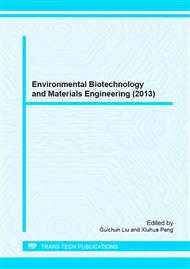[1]
Mamoru Kawaharasaki, Hideo Tanaka, Takahiro Kanagawa, Kazunori Nakamura. In situ identi-fication of polyphosphate-accumulating bacteria in activated sludge by dual staining with rRNA-targeted oligonucleotide probes and 4', 6-diamidino-2-phenylindol (DAPI) at a polyphosphate-probing concentration [J]. Water Research, 1999, 33: 257-265.
DOI: 10.1016/s0043-1354(98)00183-3
Google Scholar
[2]
Yinguang Chen, Yan Liu, Qi Zhou, Guowei Gu. Enhanced phosphorus biological removal from wastewater-effect of microorganism acclimatization with different ratios of short-chain fatty acids mixture [J]. Biochemical Engineering Journal, 2005, 27: 24-32.
DOI: 10.1016/j.bej.2005.06.003
Google Scholar
[3]
Serafim L S, Lemos P C, Levantesi C, et al. Methods for detection and visuali- zation of intracellular polymers stored by polyphosphate-accumulating microorganisms [J]. Journal of Microbiological Methods, 2002, 51(1): 1-18.
DOI: 10.1016/s0167-7012(02)00056-8
Google Scholar
[4]
Pijuan M, Saunders A M, Guisasola A, Baeza J A, Casas C, Blackall L L. Enhanced biological phosphorus removal in a sequencing batch reactor using propionate as the sole carbon source [J]. Biotechnology and bioengineering, 2004, 85(1): 56-67.
DOI: 10.1002/bit.10813
Google Scholar
[5]
Environmental Protection Agency. GB11893-89 Determination of total phosphorus Molybdate spectrophotometry [S]. Beijing: China Environmental Science Press, (1989).
Google Scholar
[6]
Bartholomew J W. Stains for microorganisms in smears. In: Clark G (Ed. ), Staining Procedures, 4th edn [M]. Baltimore, London: Williams and Wilkins. 1981: 375-440.
Google Scholar
[7]
Ren S Y, Xiao T. Staining methods for intracellular polymers deposited by polyphosphate-accumulating microorganisms [J]. Marine Sciences, 2005, 29(1): 59-63.
Google Scholar
[8]
Streichan M, Golecki J R, Schon G. Polyphosphate-accumulating bacteria from sewage plant with different processes of biological phosphorus removal [J]. FEMS Microbiology Ecology, 1990, 73(2): 113-124.
DOI: 10.1111/j.1574-6968.1990.tb03931.x
Google Scholar


